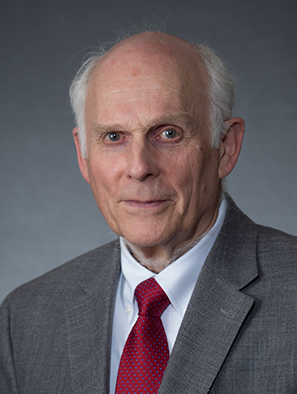
Gareth Eaton
Professor
303-871-2980 (Office)
Seeley G. Mudd Building, 2101 E. Wesley Ave. Denver, CO 80208
What I do
I teach graduate courses in chemistry and develop new methods of measuring electron spins, with grants in instrument development and preclinical imaging. My work is based on collaborations in engineering, math, physics, chemistry and oncology. I review papers for many ACS and other journals.Professional Biography
Gareth R. Eaton received his A.B. at Harvard and obtained his Ph.D. at MIT 1972. Since then he has been in the Department of Chemistry (now the Department of Chemistry and Biochemistry) at the University of Denver. He was promoted to Professor in 1980. He served as Dean of Natural Sciences from 1984-1988 and as Vice Provost for Research from 1988-1989. In 1997 he received the John Evans Professorship at the University of Denver. He teaches inorganic chemistry. His research program involves continuous wave, rapid-scan, and pulse EPR applied to the study of relaxation times, spin-spin interaction, metal ions in biological systems, and EPR imaging. He and his wife, Professor Sandra S. Eaton, have jointly authored about 380 research papers and book chapters. In 2002 they jointly received the Bruker prize and in 2008 they became Fellows of the International EPR/ESR Society. He is a Fellow of the Royal Society of Chemistry.
address: Department of Chemistry and Biochemistry, University of Denver, Denver, Colorado 80208; phone: 303-871-2980; FAX: 303-871-2254; internet: geaton@du.edu;
http://epr-center@du.edu
address: Department of Chemistry and Biochemistry, University of Denver, Denver, Colorado 80208; phone: 303-871-2980; FAX: 303-871-2254; internet: geaton@du.edu;
http://epr-center@du.edu
Degree(s)
- Ph.D., Inorganic Chemistry, Massachusetts Institute of Technology, 1972
- BA, Chemistry, Harvard College, 1962
Professional Affiliations
- American Chemical Society
- American Physical Society
- International EPR Society
- Royal Society of Chemistry
Research
The Eaton group develops instruments, experimental methods, and data analysis tools to characterize unpaired electrons and their application to biomedical problems. Spectrometers have been constructed for continuous wave, pulse, and rapid scan EPR and imaging. Free radicals and metal ions have been studied at multiple frequencies from 250 MHz to 34 GHz. Applications include in vivo imaging, protein structure determination, and studies of materials important for areas as diverse as quantum computing and solar energy. The Denver lab integrates engineering, physics, math, chemistry and biochemistry to accomplish these goals.
Areas of Research
EPR
Imaging
relaxation mechanisms
Key Projects
- Preclinical Electron Paramagnet Resonance Tumor Imager
- Low Frequency EPR Spectroscopy and Imaging
Featured Publications
. (2018). EPR imaging and in vivo EPR. Boca Raton, FL: Taylor and Francis.
. (2018). Relaxation mechanisms. In D. Goldfarb & Stoll, S. (Eds.), EPR spectroscopy: Fundamentals and methods (pp. 175-192). John Wiley and Sons.
Presentations
. (2015). 250 MHz in vivo Rapid Scan Images of pH and Thiol Reductive Status. 57th Rocky Mountain Conference on Magnetic Resonance. Snowbird, Utah: Rocky Mountain Conference on Analytical Chemistry.
. (2017). Field Stepped Rapid-Scan EPR Imaging of CTPO. ISMAR2017. Quebec City, Quebec: International Society for Magnetic Resonance.
. (2017). Electron Spin Relaxation of Nitroxides Designed for DEER Experiments. EPR-2017. Morgantown WV.
. (2018). EPR Imaging at VHF and Field Reversal Background Correction. 59th Rocky Mountain Conference on Magnetic Resonance. Snowbird, Utah: Rocky Mountain Conference on Magnetic Resonance.
Awards
- John Evans Professor, University of Denver
- Fellow of the Royal Society of Chemistry, Royal Society of Chemistry
- Bruker Prize, Royal Society of Chemistry, EPR Discussion Group
- Colorado Section Award, American Chemical Society, Colorado Section


